With the imminent release of a bumper box set of his solo work, one-time Can man Irmin Schmidt looks back over his illustrious career and talks about fleeing war-torn Berlin as a child, learning his trade under Stockhausen, and his sonic adventures in the worlds of classical music, experimental electronics, film soundtracks and fantasy operatics
“I actually just liked the idea of having all my work concentrated in one big box. It’s like when you’re a writer; there’s always the moment where your works are collected into one edition and available as one thing. It’s nice to have… and that’s it!”
So Irmin Schmidt modestly describes the motivation behind his monumental new ‘Electro Violet’ collection, which presents six CDs covering all his solo albums, then another six drawn from his enormous catalogue of TV and film soundtracks, including a disc of previously unreleased tracks. As he says, it’s nice to have. But beyond that, this epic rollercoaster ride through over 30 years of projects confirms Irmin Schmidt as one of the leading avant-garde pioneers of the last century, an artist who can easily be placed next to his early mentors Stockhausen and Ligeti.
Irmin’s shapeshifting work with Can occupied just 11 years out of the musical journey which started in the early 1960s and is still going on. Such was the magnitude of Can’s astonishing run of albums between 1969’s ‘Monster Movie’ and 1974’s ‘Soon Over Babaluma’ (after which technology impinged on their anarchic creative ethos and they diluted and fragmented during their last five years) that his solo work often fell under his old group’s vast shadow, especially when Can started to receive the kind of posthumous recognition afforded true innovators.
Born in 1937, Irmin Schmidt’s formative years were spent acquiring a formal training in classical music. He attended the conservatorium in Dortmund and several other venerable establishments, before conducting various orchestras during the 60s. But he also studied composition on Karlheinz Stockhausen’s Courses for New Music in Cologne and under innovative composer Gyorgy Ligeti between 1957 and 1967, founding the Dortmund Ensemble for New Music in 1962. Crucially, then, Irmin moved in both old school classical and forward-thinking experimental circles from his early teenage years. He started composing soundtrack music when he was a student.
“I was making music to short films from the beginning of my composing career, just for money when I was still a student,” he recalls, speaking on the phone from his home in Provence in the south of France. “Sometimes they were totally stupid, these kind of short documentaries or industry films, but I learned my craft like that. That was one part of my composing.”
And let’s not forget that Can supplied the music for a number of movies, as heard on ‘Soundtracks’ in 1970.
“We did quite a lot of nice film music, especially at the beginning, when we did ‘Deep End’ and some very famous German films. Then we were touring so we had no time for that, but soundtracks go through all of my life.”
The story of Can, formed by Irmin Schmidt, fellow Stockhausen student Holger Czukay, guitarist Michael Karoli and drummer Jaki Liebezeit, has been well documented. For Irmin, it started with his revelatory trips to New York in 1966 and 1968, when he experienced The Velvet Underground and the Fluxus art movement, meeting key figures such as La Monte Young and, at the same time, being struck by the simple power of James Brown and The Stooges. Jimi Hendrix, one of America’s major electronic innovators, had a profound effect on Irmin, particularly the Woodstock assault on ‘The Star Spangled Banner’, a moment which defined the 1960s.

“When I heard Hendrix’s ‘The Star Spangled Banner’ for the first time, it really stirred me,” he says. “It was an orchestral painting, but a solo on one guitar. It’s very emotional and full of a certain kind of expression. That’s what fascinated me in Hendrix, because what he was doing there, by the way he was playing the guitar, it was like a new instrument. And that’s what you try to aspire to as a composer. It was the same with Ligeti, who produced a new orchestra sound which had never been heard before, and Charlie Parker’s role in the modern saxophone. The sax was invented in 1840 or something and was especially used in classical music. It made very uninteresting sounds, but the moment Charlie Parker and the great jazz musicians started playing it, they turned it into the modern instrument.
“It was the same for me with electronics. Modern music for me is Igor Stravinsky and Jimi Hendrix, because they made new sounds. The synthesiser, in effect, was not yet a real instrument, so you had to create it. And with Can, I created my own. The concept was mine, but despite my work with electronic music I’m helpless with the technical side itself, so I asked an electronics engineer to build my Alpha 77, then used a totally new idea of synthesising that can be played live. This concept gave the synthesiser a new aspect in the 1970s.”
After the dissolution of Can in 1979, Irmin returned to composing soundtracks and simultaneously embarked on a solo career. The first album to bear his name was ‘Filmmusik’ in 1980, featuring his music for a movie called ‘Im Herzen Des Hurricane’, which he recorded with Swiss electronic composer and sax player Bruno Spoerri. The following year the partnership also produced Irmin’s first solo studio album, ‘Toy Planet’, one of that decade’s electronic milestones, which foreshadowed future strains such as techno as well as world music. While citing the warm, throaty contrast of Bruno’s sax as “one of the attractions for me to work with him”, Irmin underlines the importance of collaborators in his career.
“I always like to work with people who can do something I can’t, or have more knowledge of something I don’t have knowledge of. Bruno is a jazz musician and he also knew more about electronics than I did. We met and talked about electronics and he had his own ideas, so we decided to make a record together. He had a studio in Zürich so we worked there together.”
While elements from ‘Filmmusik’ appear in the soundtrack selection of ‘Electro Violet’, ‘Toy Planet’ is the first disc of the box set. After the synthetically resonating theme of ‘The Seven Game’, the title track looms as one of Irmin Schmidt’s most startling and groundbreaking pieces. Beatless and juddering, it shimmers and pulses with its own kaleidoscopic momentum.
“On that piece, I used a sample,” explains Irmin, who was presaging sampling and the soon-to-arrive Fairlight. “I built a kind of choir and let more than 24 different loops run onto each other, which led to lots of strange sounds because of this overlaying. On ‘Toy Planet’, we used our two synthesisers in a new way, combining them with concrete sounds and sample techniques that, at the time, didn’t really exist. This was the result of overlaying loops of samples, which was a different way of making a piece of music.”
Irmin cites his old teachers Stockhausen and Ligeti as pioneers of the techniques that he initially used in Can, helping to shape them into one of the seminal bands of the 1970s.
“I owe a lot of my ideas about electronics to Stockhausen,” he explains. “I studied and worked with him, which was actually based on the fact I heard ‘Gesang Der Jünglinge’, his first big electronic piece, and was so affected by it that I wanted to learn more. Electronic music got its first real masterpiece with Stockhausen in the 50s and it was a big influence on me.
“I was trained by a lot of great musicians, composers and conductors, but then I had the idea that only this music by Stockhausen and Ligeti was totally new in the 20th century. There was jazz, but here there was something in western culture that was a very different aspect of music. I had the idea that all this was new in music – seriously and genuinely new – so I wanted to bring it all together in what I was doing. Can did that and everything I’ve done ever since is the same idea from another angle.”
Irmin’s voracious quest for fresh sounds was the key element in his musical evolution after his formal training and the explorations of Can, as breathtakingly illustrated by the title track of ‘Toy Planet’ and the album’s equally startling ‘Rapido De Noir’. The latter is built on a recording of a steam train hurtling along the tracks, the locomotive surge and snake-like synth solo traversing the kind of sonic strata that came naturally to Irmin. Almost 35 years on, it still sounds like a supremely advanced piece of electronic music, even though it rides the rhythm of a now obsolete steam train and its initial inspiration came when he was fleeing wartime Berlin with his mother.
“I was only five years old, but this childhood experience influenced me very much,” he recalls. “I was fascinated by my train trips and the monotonous rhythm of the trains and all the sounds around it seemed a kind of hallucinatory world. So I had the idea of using a rhythmic basis from a train. It doesn’t exist now, but until the 90s the train made this ‘didomp-didomp’ rhythm going over the tracks, so Bruno and I edited this basic rhythm by taking a real recording of a train and then I put my music over it.
“I played the long solo on the Prophet 5, which never usually sounds like that. I used a distortion pedal for a guitar and a wah-wah pedal and other things to bring the Prophet 5 alive, because synthesiser sounds were very flat at that time. I played this solo live in one go using the pedals, which gave it special overtones. I also had little nails which I threw down onto a tiled floor and it made a very strange noise. I recorded that and transposed it higher, so it was covering the hiss and producing a new sound together with the hiss.
“That’s typical of how I worked with Can and later with Bruno, just creating with concrete sounds. I’m not the inventor of this – Pierre Schaeffer, Pierre Henry and Stockhausen worked like this too. I was the next generation and, in a way, the next generation was using a kind of different approach to recording, using the tradition and working it into further adventures in sound.”

After ‘Filmmusik Volume 2’ and other soundtrack work, including the 1983 German TV series ‘Rote Erde’, Irmin swung into another creative curve by teaming up with long-time Can supporter and affiliated wordsmith Duncan Fallowell, the English novelist and counter-culture commentator who had turned down an invitation to join Can when Damo Suzuki left in 1973. Fallowell’s lyrics took Irmin into exploring (and also singing) the songs on ‘Musk At Dusk’ in 1987 and ‘Impossible Holidays’ a few years later, which now sound like expansively reaching twin works, encompassing everything from convoluted Bowie-esque grandeur and Teutonic reggae to decadent German cellar bars of past times.
Both of these albums are elevated by the unmistakable presence of Michael Karoli’s guitar and Jaki Liebezeit’s drums, inevitably recalling late period Can outings while spinning into the unknown, as on the sweeping epic ‘The Child In History’. ‘Impossible Holidays’ continues exploring queasy cafe atmospheres while adding a sexy new dimension with the butt-friendly bass of ‘Surprise’, the piano-splashed space-funk of ‘Shudder Of Love’, and the richly dark panoply of sax, accordion and castanets draping the lustrous ‘Time The Dreamkiller’. Maybe it’s how Can might have sounded if they’d continued along a linear path, unencumbered by pressures.
“Michael and Jaki played on my solo records alongside many other musicians, but always in a way that the nucleus on these two records was actually us three. The difference to Can is that on these two records, I wrote the songs and they accepted playing them. There is still Can in it because of them. I mean, there are three Can members out of four!”
‘Gormenghast Drift’, the haunting track which ends ‘Impossible Holidays’ was an evocative pointer to Irmin’s next major project, ‘Gormenghast’, a fantasy opera in collaboration again with Duncan Fallowell. It was Fallowell who introduced him to Mervyn Peake’s trilogy of novels concerning the supremely dysfunctional Groan family in the colossal Castle Gormenghast, including the heir Titus Groan, his doomed sister Fuchsia, the power-crazed psychopath Steerpike, the sadistic chef Swelter and the evil dwarf Barquentine. Irmin was inspired to write the music, while Fallowell wrote the libretto while living in Russia in the 90s.
“I read the trilogy and a lot later this idea of an opera came into my head,” says Irmin. “That was an interesting challenge because every song in an opera or in a musical creates a character. You have to work hard to use the book’s characters to build a structure and put in the dramatic tension. When writing, you have to work very, very closely together, which Duncan and I did.”
The work was first staged at Germany’s Wuppertal Opera House in 1998. Even listening to a full-blown opera, it’s still possible to discern that the composer and performer is Irmin Schmidt.
“It was my magnum opus! Three hours of music! My idea from the beginning, and the founding of Can, was to bring in the classical music I grew up with. I’ve never wanted to give romantic harmonies a rock rhythm and that’s it. I think it’s a deeper kind of thing to use 20th century music in every aspect. You will find Bartók and Stravinsky and Ligeti and Stockhausen inside the music, just as you will also find Otis Redding and Frank Zappa and Miles Davis and John Coltrane. All this is great music created in the 20th century and, in my way of thinking, I brought it all together in a new way.
“Every musician builds on a tradition and my tradition was, on one side, the classical tradition, in which I’m totally at home. But there was another tradition based in the music that came from Africa. It’s these different traditions which sort of made a whole in my head. What I didn’t want was just to use the classical influence, like having some romantic chords. It’s much more difficult and you can hear it in the opera. I’m using unusual 19th century chords in the aria of the cook, but the way I put them together is something new, with the melody and the rhythm. Put all together, it’s a totally new aspect of 20th and 21st century music.”
The technical mastermind of the ‘Gormenghast’ opera was Irmin’s son-in-law Jono Podmore, who has been active in electronic music for over 20 years and gets up to glorious mischief on arcane kit with idiosyncratic analogue marauders Metamono. For years, he has also traded under the name Kumo and, after clicking with Irmin while working on the opera, the pair made ‘Masters Of Confusion’ (2001) and ‘Axolotl Eyes’ (2008) together.
“Kumo co-produced the opera with me and he played an important role,” says Irmin. “He knew something I didn’t. He was a whole generation younger than me. I always like to work with people who give me a new dimension of music or sound or knowledge or whatever. Kumo is a fantastic rhythm programmer and sound engineer, and we were equally responsible for the music on the two albums we did. I like teamwork. When I started with Can, it was several composers working as Can, which itself became one composer consisting of four or five individuals.”
Drawing material from shows in London, Holland and France, ‘Masters Of Confusion’ saw Jono underpin tracks such as ‘Goatfooted Balloonman’ and ‘Burning Straw In Sky’ with the sort of grooves then gripping electronic music, including trip hop and drum ’n’ bass, while a skipping house beat propels ‘Those Fuzzy Things (Out There)’. ‘Axolotl Eyes’ was meanwhile crafted out of extended jams recorded at Cologne’s Studio B and Irmin’s home studio, then edited in London with guests including avant jazz trumpeter Ian Dixon and singer Paul J Fredericks. All told, the Irmin-Kumo collaborations are a volatile, highly fruitful collision between two restless musical souls on an untainted mission into the beyond.
‘Electro Violet’ is released on Spoon/Mute






